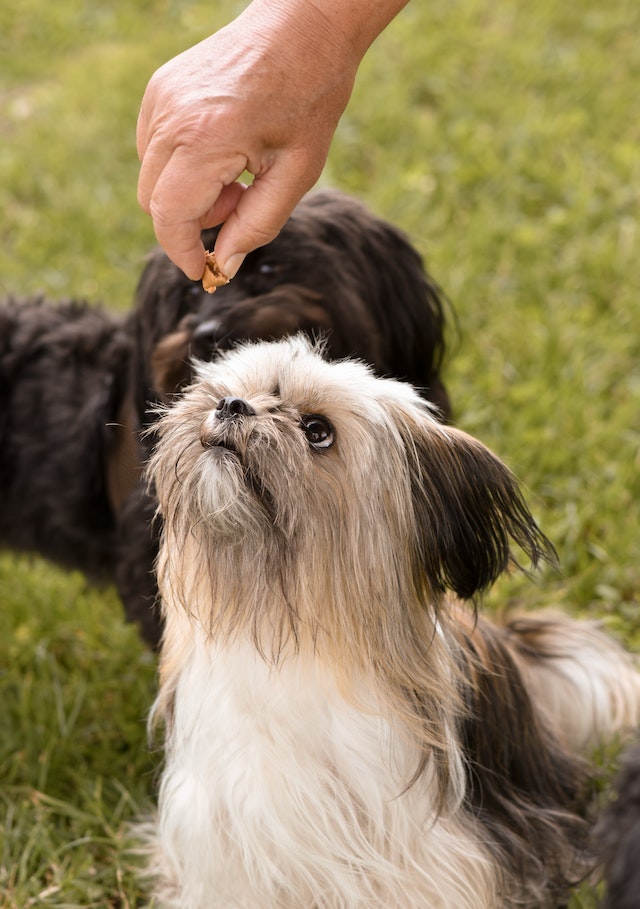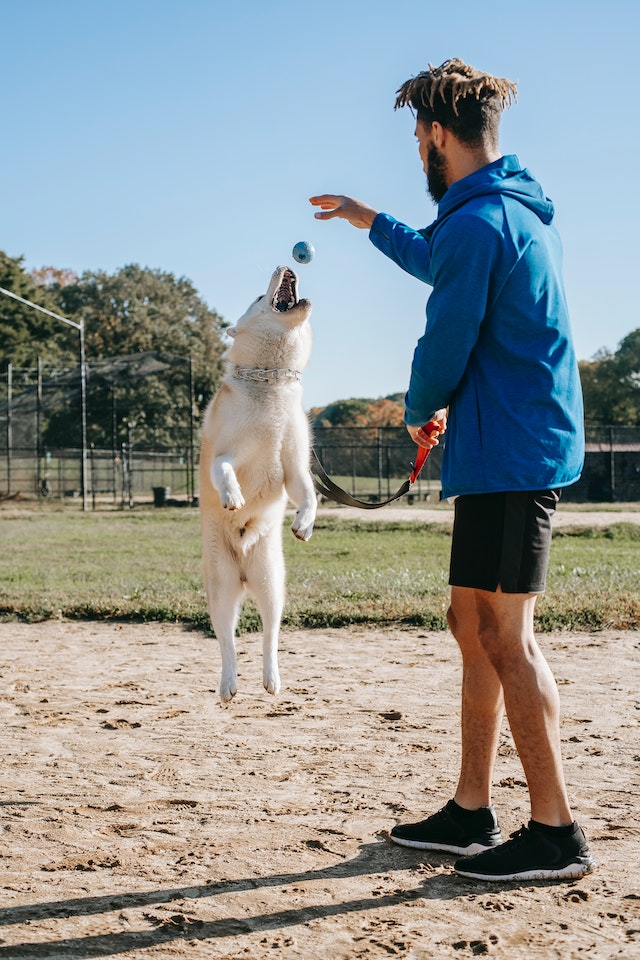"Reward Marker Dog Training"
Note: This article was taken, in part, from a much longer piece written by Ed Frawley, owner of Leerburg.com. Click here to see the article in its entirety. We present this article because we heavily use Reward Marker Training (along with other methods) in our dog training philosophy here at Rapid Results Dog Training.

So What Exactly Is Marker Training?
In technical terms marker training is operant conditioning. Operant conditioning has been around for years. It is how Dolphins are trained at sea world.
Operant conditioning forms an association between a behavior and a consequence.
I can see new dog trainers reading this and shaking their heads thinking “Dahhhh isn’t that pretty obvious and what all dog training is about?”
My answer to that is “YES” but let’s go into a little more detail.
When a dog exhibits a behavior we like the consequence is a high value reward. In marker training that reward is either a high value food treat or a high value toy that the dog really loves. If a dog does not perform a behavior the consequence is “No Reward.” This is called a negative reinforcer. When a dog gets a negative reinforcer it must then repeat the exercises if it wants to get the high value reward.
In old school dog training the consequence of a negative behavior was a correction.
No matter what anyone ever tells you dogs do things for themselves. Dogs don’t do things to make you feel good. They do things to make themselves feel good. They do things because they are motivated towards feeling comfortable in addition to doing things that eliminate feeling discomfort. This is a pretty profound concept and one that pet owners often miss. Pet owners or new dog trainers are often lead to believe that dogs will eventually do things to make their owner feel good. The reality is that this is seldom if ever the case.
So the key to operant conditioning is to teach a dog that when he performs a behavior that we like he gets a reward that makes him feel good – the reward gives him a level of comfort. This reward can either be in the form of a food or it can be a toy he likes to play with or playing a game with the handler that he gets enjoyment out of or he gets praise from his handler(which he likes). In all my years of dog training I have only known one dog that would work strictly for handler praise.
In the marker training system there are only two consequences to a behavior that we are trying to train. They are a reward or no-reward. Which consequence happens depends on the behavior the dog exhibits to a stimulus. A stimulus can be a command or a cue (or lure) from the handler.
For dogs to associate a behavior with a reward or with punishment the reward or punishment must come immediately after the behavior. We tell people the consequence should come within a 1/2 second of the behavior. If a reward comes 5 seconds after a behavior the dog has no idea why he is getting a reward. If a new dog owner comes home and finds a pile of dog poop in his kitchen and he proceeds to rub the dogs nose in it, that dog doesn’t have a clue why he is getting punished.
Now if the same dog has been on leash in the kitchen and peed on the floor and the handler had scolded him the instant he saw the dog pee – the dog would associate the scolding with peeing – because it came within 1/2 second of the behavior.


In training it is not always possible to reward within a 1/2 second. In fact no matter how hard you try you cannot consistently reward a dog within 1/2 second. The get around this we bridge (or connect) the time frame between the behavior and the consequence that follows. This bridge allows us to extend the 1/2 second rule of consequences. That bridge is a word – we will call it a Marker (I like to use the word YES, other people use other words). Many people use the sound from a clicker. The fact is you can use any word or sound you are comfortable with as long as you are consistent.
A simple way to look at the mark as a bridge is that it is like telling your dog “Hold on a second – I like what you just did and I am going to get to you and give you a high value reward.”
There are positive and negative markers. The word for a negative Marker is “NO” or “NOPE.” It is important to mention that a negative marker is not a correction. It is simply a way of communicating to the animal that he just made a mistake and if he expects to get that high value reward he needs to redo the behavior correctly.
Through repetition the dog learns that every time he hears the positive Marker he gets a reward. Every time he hears the negative Marker he does not get a reward and he has to repeat the behavior or exercise.
Dogs that are trained with markers become problem solvers. They have learned (through the concept of negative reinforcement) that when one behavior doesn’t work they need to try something else and if that doesn’t work they just keep trying because if they try long enough they have a good chance of figuring out what you want and getting a high value reward.
The system allows trainers to reinforce correct behavior with “pin point accuracy” from a distance. It also allows dogs to make mistakes and then learn from their mistakes. The beauty of the system is that it also allows us to pin point the exact moment a dog makes a mistake, without correcting the dog in the process.
This is radically different from old school dog training where dogs are corrected for doing something wrong. I remember the day when we would take an untrained dog and march down the street with the dog on a leash. We would do a quick left turn, right turn or about turn as we said “HEEL” and give the dog a correction for not staying by our side. When I stop and think about it – how unjust was this to my dogs. It was a terrible way to train. It created dogs that were afraid to try and think on their feet because if they made a mistake they would get a correction.
Training with Markers is a simple concept to understand. It only takes a few minutes to explain why it works but it can take years to master. The journey is exciting and well worth the trip. Along the way you will find that your dogs are a lot smarter than you once thought.
Those days are long gone with marker trainers.

Free 20 minute - No obligation Consultation in your home.
CUSTOMER REVIEWS





Free 20 minute - No obligation Consultation in your home.
Serving the Following Communities
We do professional, reliable dog training in the following communities: Avon, Avon Lake, Bay Village, Beachwood, Bedford, Bedford Heights, Bentleyville, Berea, Bratenahl, Brecksville, Broadview Heights, Brook Park, Brooklyn, Brooklyn Heights, Chagrin Falls,
 Cleveland, Cuyahoga Heights, Euclid, Fairview Park, Garfield Heights, Gates Mills, Glenwillow, Highland Heights, Hudson. Hunting Valley, Independence, Lakewood, Linndale, Lyndhurst, Macedonia, Maple Heights, Mayfield Heights, Mayfield, Middleburg Heights, Moreland Hills, Newburgh Heights,
Cleveland, Cuyahoga Heights, Euclid, Fairview Park, Garfield Heights, Gates Mills, Glenwillow, Highland Heights, Hudson. Hunting Valley, Independence, Lakewood, Linndale, Lyndhurst, Macedonia, Maple Heights, Mayfield Heights, Mayfield, Middleburg Heights, Moreland Hills, Newburgh Heights,
North Olmsted, North Randall, North Royalton, Oakwood, Olmsted Falls, Olmsted Township, Orange, Parma, Parma Heights, Pepper Pike, Richmond Heights, Rocky River, Seven Hills, Shaker Heights, Solon, South Euclid, Strongsville, Twinsburg, University Heights, Valley View, Walton Hills, Warrensville Heights, Westlake, and Woodmere.
Also serving Geauga County
Bainbridge, Burton, Chagrin Falls, Chardon, Chesterland, Newbury, and Novelty.
As well as Lake county
Novelty, Fairport Harbor, Grand River, Kirtland, Lakeline Village, Perry Township, Perry Village, Painesville, Painesville Township, Mentor, Mentor-on-the-Lake, Wickliffe, Willoughby, Willoughby Hills, and Willowick.
Back to Top
